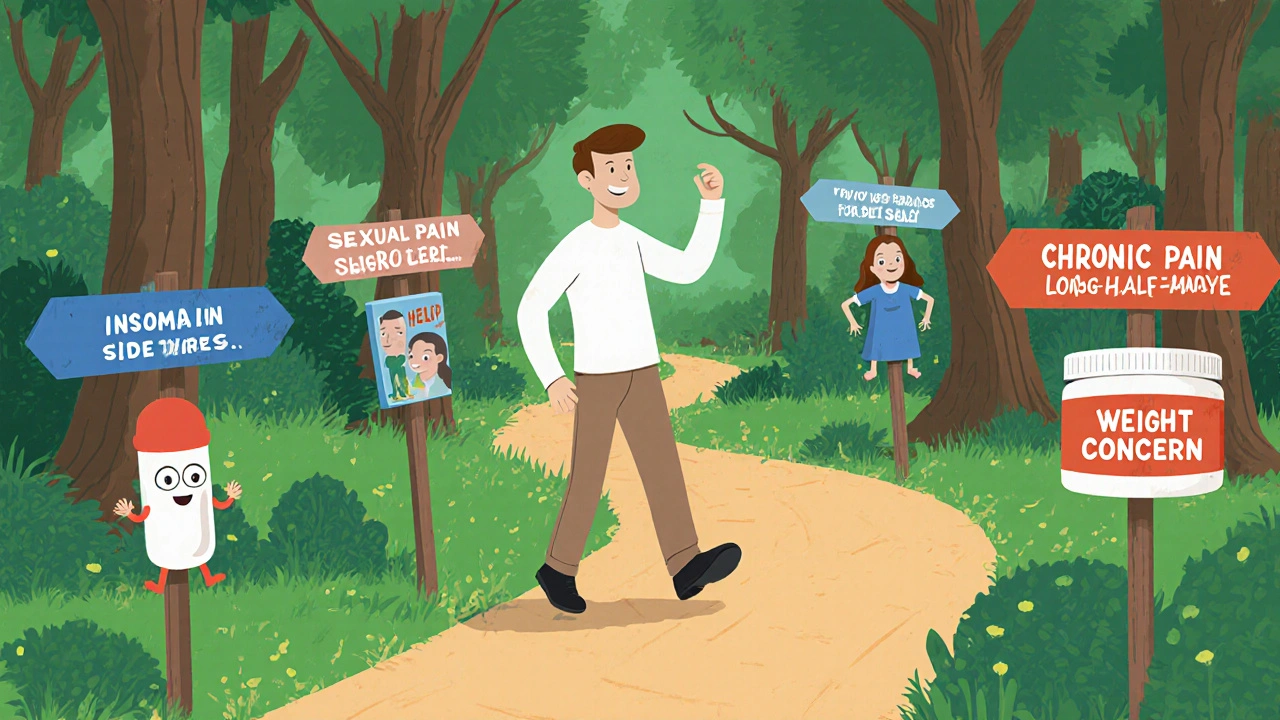Celexa (Citalopram) vs. Alternative Antidepressants: A Detailed Comparison

Antidepressant Decision Guide
Answer a few questions about your symptoms and needs to identify which antidepressants might be most appropriate for you.
Based on your answers:
Key Takeaways
- Celexa (citalopram) is a well‑tolerated SSRI often chosen for its simple dosing.
- Escitalopram offers similar efficacy with a slightly better side‑effect profile for some patients.
- Sertraline and fluoxetine have more activating effects, which can help with fatigue but may increase anxiety.
- SNRIs such as venlafaxine and duloxetine add norepinephrine boost, useful for pain‑related depression.
- Non‑serotonergic options like bupropion and mirtazapine are valuable when sexual side effects or weight loss are concerns.
When treating major depressive disorder, Celexa (generic name Citalopram) is an SSRI antidepressant that works by increasing serotonin levels in the brain. It’s been on the market for more than two decades, and many clinicians regard it as a solid first‑line choice. Still, patients and prescribers often wonder how it stacks up against other pills that promise similar relief. This guide breaks down the most common alternatives, looks at the science behind each, and gives you a practical way to decide which one fits your situation best.
What Is Celexa (Citalopram)?
Citalopram belongs to the selective serotonin reuptake inhibitor (SSRI) class. By blocking the serotonin transporter, it lets more serotonin stay available in the synaptic gap, easing low mood, anxiety, and related symptoms. Standard adult dosing starts at 20 mg once daily, with a typical maximum of 40 mg (some countries have lowered the ceiling to 20 mg because of QT‑interval concerns). The drug’s half‑life is roughly 35 hours, meaning steady‑state levels are reached in about a week.
Key advantages include a low risk of weight gain, minimal anticholinergic activity, and a relatively simple side‑effect profile. Common complaints are mild nausea, dry mouth, and, for a small subset, sexual dysfunction. Because it has few active metabolites, citalopram is less likely to interact with other medicines compared with some older antidepressants.

How Celexa Works Compared to Other Classes
All SSRIs share the serotonin‑boosting mechanism, but subtle differences in chemical structure affect binding affinity, side‑effects, and drug‑drug interactions. Citalopram is a racemic mixture; its mirror image escitalopram (the S‑enantiomer) is responsible for most of the therapeutic effect, which is why escitalopram often shows slightly higher potency at lower doses.
Other classes-SNRIs (e.g., venlafaxine, duloxetine), atypical agents (bupropion, mirtazapine), and older tricyclics-target additional neurotransmitters such as norepinephrine, dopamine, or histamine. Those extra actions can be a boon for certain symptom clusters (pain, low energy, insomnia) but also bring a broader side‑effect spectrum.
Common Alternatives to Celexa
Below is a quick snapshot of the most frequently prescribed alternatives. Each entry includes the brand name, primary class, and a one‑sentence highlight.
- Escitalopram (Lexapro) - an SSRI with a tighter binding profile, often praised for lower sexual side effects.
- Sertraline (Zoloft) - an SSRI known for its energizing effect, useful when fatigue dominates.
- Fluoxetine (Prozac) - the longest‑acting SSRI, helpful for patients who struggle with adherence.
- Venlafaxine (Effexor) - an SNRI that adds norepinephrine boost, beneficial for pain‑related depression.
- Duloxetine (Cymbalta) - an SNRI with FDA approval for diabetic neuropathic pain and chronic musculoskeletal pain.
- Bupropion (Wellbutrin) - a norepinephrine‑dopamine reuptake inhibitor (NDRI) that rarely causes sexual dysfunction.
- Mirtazapine (Remeron) - a tetracyclic antidepressant that promotes sleep and appetite, ideal for patients with insomnia or weight loss.

Detailed Comparison: Efficacy, Side Effects, and Practicalities
| Metric | Celexa (Citalopram) | Escitalopram | Sertraline | Fluoxetine | Venlafaxine | Duloxetine | Bupropion | Mirtazapine |
|---|---|---|---|---|---|---|---|---|
| Typical Starting Dose | 20 mg QD | 10 mg QD | 50 mg QD | 20 mg QD | 37.5 mg QD | 30 mg QD | 150 mg QD | 15 mg QD |
| Half‑Life | ≈35 h | ≈27 h | ≈26 h | ≈4‑6 d | ≈5 h (short) / 11 h (long) | ≈12 h | ≈21 h | ≈30 h |
| Key Advantage | Simple dosing, low weight gain | Higher potency, less sexual side‑effects | More activating - helps fatigue | Long half‑life - forgiving missed doses | Added norepinephrine - better for pain | Dual action + pain indication | Stimulating, no sexual side‑effects | Sedating, appetite‑stimulating |
| Common Side Effects | Nausea, dry mouth, sexual dysfunction | Similar to Celexa, slightly less sexual impact | Diarrhea, insomnia, sexual dysfunction | Insomnia, agitation, GI upset | Hypertension, sweating, sexual dysfunction | Nausea, dry mouth, increased blood pressure | Insomnia, dry mouth, tremor | Weight gain, sedation, constipation |
| Cost (US, generic, per month) | $10‑$15 | $12‑$18 | $10‑$14 | $8‑$12 | $15‑$20 | $14‑$19 | $20‑$25 | $13‑$18 |
All numbers are averages from 2024‑2025 pricing surveys and may vary by pharmacy or insurance plan.
Efficacy
Meta‑analyses published in 2023 show that most SSRIs, including citalopram and escitalopram, achieve remission rates around 30‑35 % in moderate‑to‑severe depression. Sertraline and fluoxetine edge slightly higher in younger adults, likely due to their energizing profile. SNRIs such as venlafaxine and duloxetine often outperform pure SSRIs in patients who also report chronic pain, with remission bumps of 5‑7 %.
When it comes to treatment‑resistant cases, adding bupropion or switching to mirtazapine can provide a 10‑15 % increase in response, especially if sexual side effects or appetite loss have undermined adherence.
Side‑Effect Tolerance
Sexual dysfunction remains the most cited complaint for SSRIs. Escitalopram scores marginally better, while bupropion is practically neutral. Sedation is a hallmark of mirtazapine, making it a go‑to for patients who struggle to sleep. On the flip side, its weight‑gain tendency can be a deal‑breaker for others.
Cardiac concerns: high doses of citalopram (>20 mg in many countries) have been linked to QT‑interval prolongation. That’s why clinicians often cap the dose at 20 mg for most adults unless the benefit clearly outweighs the risk.
Drug Interactions
Because citalopram is metabolized primarily by CYP2C19 and CYP3A4, it has fewer interactions than fluoxetine (a strong CYP2D6 inhibitor). However, combining any SSRI with monoamine oxidase inhibitors (MAOIs) can trigger serotonin syndrome, so a washout period of at least 14 days is recommended.
Venlafaxine and duloxetine share CYP1A2 and CYP2D6 pathways, meaning they can interact with certain antibiotics and antifungals. Bupropion induces CYP2D6, potentially lowering plasma levels of many co‑prescribed drugs.
Special Populations
- Elderly: Lower doses of citalopram (10‑20 mg) are advised to reduce fall risk and QT prolongation.
- Pregnancy: All SSRIs cross the placenta; data suggest citalopram carries a relatively low risk of major malformations, but clinicians often switch to sertraline if possible.
- Patients with liver disease: Dose adjustments are needed for duloxetine and venlafaxine, while citalopram is relatively safe due to minimal hepatic metabolism.
Decision Guide: Which Antidepressant Fits Your Needs?
Below is a practical flow you can run through with your doctor or pharmacist. It’s not a substitute for professional advice, but it helps clarify the trade‑offs.
- Is insomnia a major symptom?
Yes → Consider mirtazapine or low‑dose trazodone (off‑label). No → Continue. - Do you experience significant sexual side effects on current therapy?
Yes → Switch to escitalopram, bupropion, or consider adding a PDE‑5 inhibitor. - Is chronic pain (e.g., fibromyalgia, neuropathy) part of your picture?
Yes → Venlafaxine or duloxetine are strong candidates. - Do you need a medication with a long half‑life for easier adherence?
Yes → Fluoxetine may be best. - Are you on multiple meds that use CYP2D6?
Yes → Avoid fluoxetine and paroxetine; citalopram or sertraline are safer. - Is weight gain a concern?
Yes → Avoid mirtazapine; consider bupropion.
The outcome of this checklist points you toward one or two likely options. Discuss the results with a clinician, who will also consider your medical history, previous medication trials, and personal preferences.

How to Switch Safely
Switching antidepressants can trigger withdrawal or temporary symptom spikes. A taper‑and‑start approach is usually recommended:
- Reduce the current dose by 25 % every 1‑2 weeks.
- Introduce the new medication at a low dose once the previous drug is at its lowest effective level.
- Monitor mood and side effects daily for the first two weeks.
- Contact your prescriber immediately if you notice heightened anxiety, insomnia, or suicidal thoughts.
Some clinicians use a cross‑taper, overlapping both drugs for a short period, especially when moving between two SSRIs.
Bottom Line
Celexa remains a reliable, cost‑effective SSRI for many adults, but it isn’t a one‑size‑fits‑all solution. Alternatives like escitalopram, sertraline, venlafaxine, duloxetine, bupropion, and mirtazapine each bring a distinct mix of potency, side‑effect profile, and extra therapeutic benefits. By matching the drug’s strengths to your specific symptoms-whether it’s insomnia, pain, sexual dysfunction, or weight loss-you increase the odds of a smoother recovery.
Can I take Celexa and bupropion together?
Yes, the combination is sometimes prescribed to offset SSRI‑related sexual side effects, but dosage must be carefully managed to avoid seizures in high‑risk patients.
How long does it take for Celexa to start working?
Most people notice mood improvement after 2‑4 weeks, though the full therapeutic effect can take up to 8 weeks.
Is Celexa safe during pregnancy?
Data suggest a relatively low risk of birth defects, but doctors often prefer sertraline because of a larger safety database.
What should I do if I miss a dose of Celexa?
Take the missed dose as soon as you remember, unless it’s close to the next scheduled dose-in that case, skip the missed one and continue normally.
Why does Celexa sometimes cause heart rhythm changes?
High doses can prolong the QT interval, a measure of heart electrical activity. That’s why many guidelines cap the dose at 20 mg for most adults.

If you think picking any SSRI is a trivial decision, you’re ignoring the ethical responsibility physicians owe to patients. Celexa’s modest side‑effect profile may look appealing, but the QT‑interval risk at higher doses demands vigilance. Moreover, the drug’s interaction slate, though lighter than fluoxetine’s, still includes CYP2C19 substrates that can subtly alter metabolism. In clinical practice, we must weigh the modest cost advantage against the potential cardiac monitoring requirements. Ultimately, treating depression is not a one‑size‑fits‑all, and thoughtful selection should reflect both safety data and patient lifestyle.
While the article lists cost, it omits insurance tier nuances that can double out‑of‑pocket expenses for citalopram.
When evaluating Celexa against its alternatives, it is essential to consider the pharmacokinetic timeline, especially the half‑life of roughly 35 hours, which influences steady‑state attainment and withdrawal phenomena. A longer half‑life generally provides a smoother tapering process, reducing the likelihood of abrupt discontinuation syndromes that can confound clinical assessment. In contrast, medications like venlafaxine have a much shorter half‑life, necessitating more cautious cross‑taper strategies to avoid rebound hypertension or anxiety spikes. Additionally, the racemic nature of citalopram means that only the S‑enantiomer, escitalopram, contributes significantly to serotonin reuptake inhibition, a fact that underlies the latter’s higher potency per milligram. From an efficacy standpoint, meta‑analyses from 2023 indicate remission rates for citalopram hovering around 32 %, a figure that aligns closely with other SSRIs but falls short of the modest edge observed with sertraline in younger cohorts. Side‑effect profiles further differentiate these agents; Celexa’s sexual dysfunction rates are comparable to other SSRIs, yet its propensity for QT prolongation at doses above 20 mg cannot be dismissed, especially in patients with pre‑existing cardiac risk factors. The risk–benefit calculus also shifts when comorbid conditions are present: for individuals battling neuropathic pain, an SNRI such as duloxetine may deliver dual benefits that Celexa cannot provide. Conversely, patients plagued by insomnia might find mirtazapine’s sedative properties more therapeutic, despite its weight‑gain potential. Cost considerations, while often highlighted, should be contextualized within formulary tier structures, where generic citalopram may appear inexpensive but could incur higher co‑payments under certain plans. Drug‑drug interactions remain a critical pillar of decision making; citalopram’s metabolism via CYP2C19 and CYP3A4 generally spares patients from the extensive inhibitory effects seen with fluoxetine’s CYP2D6 blockade. Nevertheless, co‑administration with other CYP2C19 substrates, such as certain proton‑pump inhibitors, may modestly elevate plasma levels, warranting dose adjustments. Patient preference also plays a decisive role, as some express intolerance to the activating side effects of sertraline, favoring Celexa’s more neutral stimulant profile. In practice, clinicians often start with a low dose of citalopram, monitor ECGs when warranted, and assess tolerability before considering escalation. Should adverse effects emerge, the flexibility to switch to escitalopram, which offers a similar mechanism with a potentially superior side‑effect spectrum, exemplifies the nuanced approach required. Ultimately, the choice between Celexa and its alternatives should emerge from an individualized matrix that balances pharmacology, comorbidities, safety, and patient values.
Celexa’s dosing simplicity makes it a convenient option for many patients.
When insomnia dominates the clinical picture, considering mirtazapine before an SSRI could spare patients from sleepless nights.
What the guide overlooks is that “simple dosing” is a marketing cliché; even a once‑daily pill can become complicated if the patient must endure frequent ECG monitoring.
It’s easy to feel overwhelmed by the array of choices, but focusing on the symptom that troubles you most can narrow the field dramatically.
Start with a low dose, give it a few weeks, and keep a symptom diary; you’ll soon see whether Celexa aligns with your goals or if a switch is deserved.